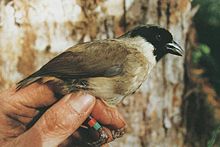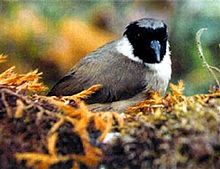- Poʻouli
-
Poʻouli 
Photo by Paul E. Baker Conservation status Scientific classification Kingdom: Animalia Phylum: Chordata Class: Aves Order: Passeriformes Family: Fringillidae Subfamily: Drepanidinae Tribe: Drepanidini Genus: Melamprosops
Casey & Jacobi, 1974Species: M. phaeosoma Binomial name Melamprosops phaeosoma
Casey & Jacobi, 1974The Poʻouli or Black-faced Honeycreeper (Melamprosops phaeosoma [2]) is a critically endangered and possibly extinct bird species that is endemic to Hawaiʻi. It is considered to be a member of the Drepanidinae (Hawaiian honeycreeper) subfamily, and is the only member of its genus Melamprosops. Po'ouli are brown above, greyish-white below, with broad black mask extending behind eye. Adults are silvery-grey above mask, shading into brown of crown, with bold, pale patch just behind mask. Juveniles are similar but buffier below with smaller mask and without grey above. Most earlier published images of the Po'ouli were of the juvenile plumage.
Contents
Discovery, taxonomy and behavior
The Poʻouli was not discovered until 1973 by students from the University of Hawaiʻi, who found the bird on the north-eastern slopes of Haleakala on the island of Maui. It was found during the Hana Rainforest Project at an altitude of 1,980 metres (6,500 ft) above sea level. The Poʻouli was the first species of Hawaiian Honeycreeper to be discovered since 1923. It is dissimilar to other Hawaiian birds. Evidence based on DNA suggests it belongs to an ancient lineage of honeycreepers[citation needed]. It appears to have out-lived all its close relatives; that is if it had any close relatives. No other bird - living or fossil - has a structure similar to it.[citation needed]
It feeds mostly on snails, insects, and spiders and nests in native ‘ōhi‘a lehua (Metrosideros polymorpha) forests.
Status
In the past, according to fossil records, it seems that the bird lived on the dry half of the island of Maui, across southwestern slope of Halekala at altitudes of 275–1,350 metres (902–4,430 ft).[citation needed] 200 Poʻouli were estimated to exist when the species was first discovered. There were only 76 birds per km². By 1981, there were only 15 birds per km². By 1985, there were only 8 per km². That meant that from the year 1975, when it was first discovered, to 1985, only ten years later, the population had dropped by over 90 percent. In the 1980s, the Poʻouli disappeared from the easternmost part of its range and was now only found in the western branch of the Hanawi Stream.
To preserve the Poʻo-uli and other endangered fauna and flora, the State of Hawaii established the 9,500-acre (38 km2) Hanawi Natural Area Reserve. This connected several protected areas to make one larger protective area. This protection effort was only possible due to the work of several groups: the government, Maui County, the National Park Service, The Nature Conservancy, and several private companies. The land was fenced off and by June 1996 they began to clear out the pigs from the closed areas. Four years and 202 pigs later, the Poʻouli pen was completely cleared of pigs. As more pigs were removed from the other two pens, population of native species that lived there, e.g. the Maui Parrotbill and ʻAkohekohe, rose slightly faster than they otherwise would have. Rats, cats, and goats were still being removed from the Poʻouli pen.
By 1997, only three individuals were known to exist. These had home ranges within the Hanawi Natural Area Reserve and the adjacent Haleakala National Park.
In 2002, one of these, a female, was captured and taken to a male's home range in an attempt to get them to breed. The female, however, had flown back to her own territory, which was 1.5 miles (2.4 km) away, by the next day. There was also a ten-day expedition in 2004. The goal of this was to capture all three birds and bring them to a bird conservation center on the island, in the hope they would produce offspring.
On September 9, 2004, one of the remaining birds, a male, was captured and taken to the Maui Bird Conservation Center in Olinda, in an attempt to captively breed the bird. However, biologists could not find a mate for the male before it died on November 26, 2004.[3]
Tissue samples have been taken from the male for possible future cloning, but as neither birds of the opposite sex are now available nor natural behavior can be imprinted on possible cloned individuals,[4] this does not seem probable. As such efforts would likely compete with conservation funding of extant bird species, it may not even be desirable as a cloning attempt would both be highly likely to fail and at the same time jeopardize the survival of other highly threatened species. If the two remaining birds still survive, they are at least ten years of age, nearing the end of their life, and probably have not been fertile for a few years. It is uncertain whether they are a male and female, or both are of the same sex. Since 2004, extensive surveys have failed to locate these or other individuals of this species and it could be extinct, but remains listed as Critically Endangered by BirdLife International (and thereby IUCN) until additional surveys have confirmed its extinction beyond reasonable doubt.
The dramatic population decline has been attributed to a number of factors, including habitat loss, mosquito-borne diseases, predation by pigs, rats, cats, and Small Asian Mongooses, and a decline in the native tree snails that the Poʻouli relies on for food.
Popular culture
The Po'ouli bird is referenced in a lounge inspired number less elegy than celebratory memorialization, Po'ouli, appearing on John Zorn's album O'o (another extinct endemic bird species of Hawai'i Nei) along with a number of other Hawai'iana tracks and bird songs of species illustrated on the albums cover. The personnel on the sessions compose a New York underground supergroup, consisting of Mark Ribot, Trevor Dunn, among others.
Footnotes
- ^ "Melamprosops phaeosoma". IUCN Red List of Threatened Species. Version 2010.2. International Union for Conservation of Nature. 2010. http://www.iucnredlist.org/apps/redlist/details/149634. Retrieved 30 August 2010.
- ^ Etymology: "black-faced bird with brownish body". Melamprosops, "black-faced", from Ancient Greek melas (μέλας) "black" + prosopo (πρόσωπο) "face". phaeosoma, "brownish-bodied", from Ancient Greek phaios (φαιός) "brown-grey" + soma (σώμα) "body".
- ^ Powell, Alvin (2008) The Race to Save the World's Rarest Bird - The Discovery and Death of the Po'ouli, Stackpole Books: Mechanicsburg, PA, p.26.
- ^ Assuming that cloning of birds will actually be established as a working technique, which neither is currently the case, nor does it seem to be in the foreseeable future.
References
- BirdLife International (2007b): Poʻo-uli - BirdLife Species Factsheet. Retrieved 2007-AUG-28.
- Phalen, D.N., Groombridge, J. (2003). Field research in Hanawi: A story about working with the world's most endangered bird. Journal of Avian Medicine and Surgery 17:39-42
- Pukui, Mary Kawena & Elbert, Samuel H. (1986): Hawaiian Dictionary. University of Hawaiʻi Press, Honolulu. ISBN 0-8248-0703-0
- VanderWerf, Eric A.; Groombridge, Jim J.; Fretz, J. Scott & Swinnerton, Kirsty J. (2006): Decision analysis to guide recovery of the po‘ouli[sic], a critically endangered Hawaiian honeycreeper. Biological Conservation 129: 383-392. doi:10.1016/j.biocon.2005.11.005 (HTML abstract)
External links
Categories:- IUCN Red List critically endangered species
- Drepanidinae
- Hawaiian honeycreepers
- Endemic fauna of Hawaii
- Critically endangered fauna of the United States
Wikimedia Foundation. 2010.




